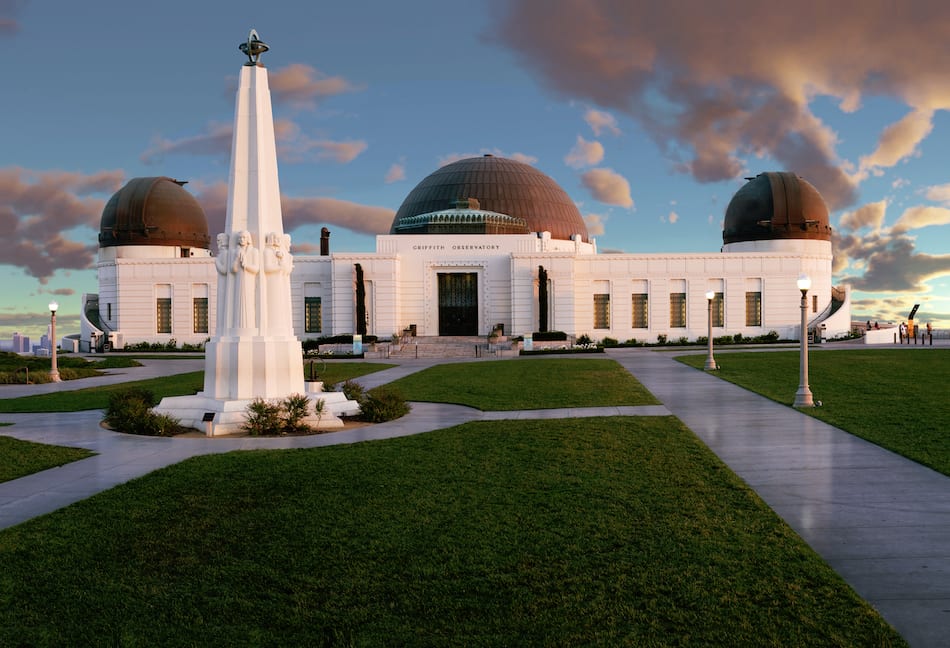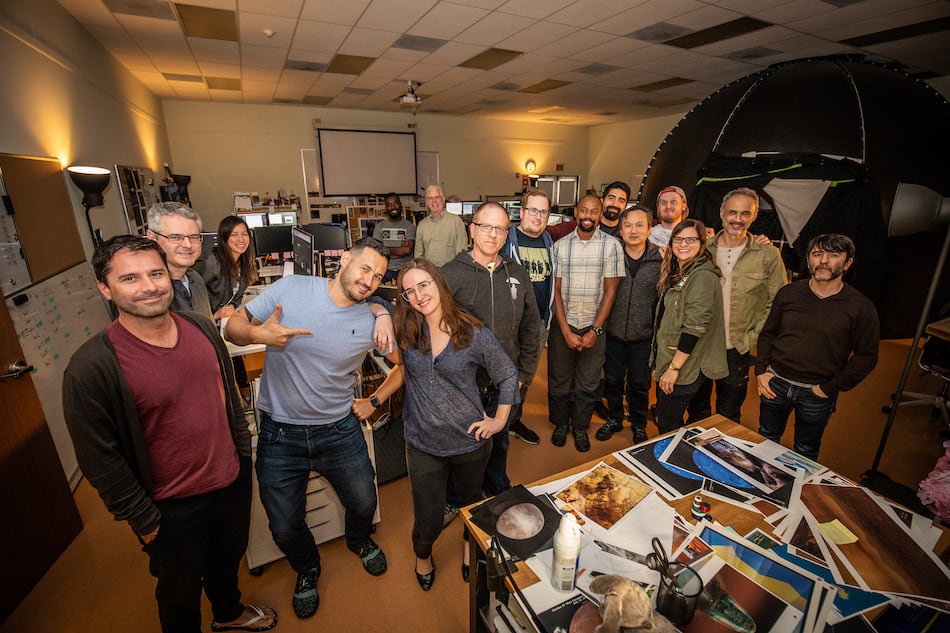The team and tech behind the Griffith Observatory’s new planetarium show

In the northeastern corner of Los Angeles’ Griffith Park, in a small and anonymous-looking building formerly used for archival storage, in a tent-like dome furnished with a half-dozen or so beach chairs, Dawn Fidrick (MFA 2010 Computer Art) boots up a laptop and projector. A series of brief computer animations play on the dome’s ceiling, showing everything from multiplying bacteria to a girl playing in a backyard to the ice that makes up Saturn’s rings. Some of the sequences are skeletal outlines; others are impressively photorealistic. Nearly all of them, Fidrick says, are “what we call CBB: Could Be Better.”
For the past three years, Fidrick, a former theater director and stage manager, has worked as the VFX producer for the Griffith Observatory. Set high on Griffith Park’s Mount Hollywood, the observatory—operated by the city of Los Angeles, with support from the nonprofit Friends of the Observatory—is as famous for its role in popularizing astronomy as it is for its expansive views; the institution claims 1.6 million visitors each year. Fidrick has been working on the project she is reviewing now, in one form or another, more or less since she started her job. In a matter of months, the footage will be completed. Set to an original score and accompanied by live narration, it will make up Signs of Life, the new show at Griffith’s Samuel Oschin Planetarium, premiering in May 2020.
Signs of Life, Oschin’s first marquee production in 12 years, has grand ambitions. Using a script developed by observatory director Dr. Edwin C. Krupp, observatory curator Dr. Laura Danly and staff astronomers, in consultation with scientists from NASA and Harvard Medical School and the Natural History Museum in Los Angeles, it examines the current science in the search for life in the universe. Only recently, for example, did scientists discover that there could be billions of earth-like planets orbiting other stars—and that the universe is awash in water, a key ingredient in the recipe for life.
Technically and creatively, Signs of Life aims to be a marvel. Aside from some traditional star projections, all of its imagery will be painstakingly detailed computer animation. To achieve these, Fidrick, along with Signs of Life’s director Don Dixon and co-producer and co-director Bob Niemack, both longtime industry veterans, put together a team of 25 artists and production personnel of varied backgrounds. Some, like Fidrick and Ruel Smith (BFA 2004 Computer Art), have a background in film. Before joining Griffith, Fidrick worked on blockbusters like Star Trek: Into Darkness, and Smith’s resume includes effects for Captain Marvel and Black Panther; other team members have worked at such outfits as Bad Robot and DreamWorks. Still others have a more typical astronomical animation background. Two are former observatory museum guides.
The team’s work is “a careful balance between the art of storytelling and the science of the real,” Niemack says. Using data sets taken from NASA’s Mars Reconnaissance Orbiter, Fidrick and her colleagues mapped out the surface of the Red Planet. The team consulted with Dr. Gael McGill, director of molecular visualization at Harvard Medical School, on the accuracy of animations showing microbes and strands of DNA. Scenes with human characters use motion-capture shot in-house and transferred to animation using a complex workflow specially developed for the show by Smith.
But imagination came to the fore when developing ways of illustrating concepts, and of moving from scene to scene. Given the immersive nature of a planetarium show, with the visuals extending to the limits of the audience’s peripheral vision, traditional filmmaking cuts and fades can be jarring, Smith says. (And excessive movement in the animation can induce motion sickness in more susceptible viewers: “There’s a fine line between being making it fun and making someone throw up,” Fidrick says.)
“We have to produce really long sequences,” says Smith, who, as animation supervisor, not only creates animations but develops and oversees the overall process and pipeline. “Sometimes they’re over 4,000 frames, with multiple characters—realistic humans, animals and insects—interacting all around the viewer.”
The team also developed a number of inventive segues, some of which required weeks of work. At one juncture, for instance, the audience gazes into the spherical camera lens of a Mars rover only to have that lens transform into a planet. And transitions from one part of the universe to another involve what Fidrick calls a “whoosh,” in which viewers travel through a field of streaming stars, like a ship jumping to hyperspace in a sci-fi film. Here, though, the positions of the stars correspond to those of real stellar objects drawn from an astronomical database.
“We’re staying as true to the science as possible while creating an experience,” Fidrick says.
Then of course there is the gear. The 290-seat Oschin Planetarium is equipped with a top-of-the-line Zeiss star projector, which sits in the center of the room, and six digital projectors are arrayed along the perimeter; these beam 24 channels’ worth of imagery on the 76-foot-diameter domed ceiling at 8,192-by-8,192-pixel resolution.
Depending on its complexity, a single frame of this size and fidelity can take up to an hour for a computer hard drive to render, or finalize. At approximately 34 minutes, Signs of Life will feature some 122,400 frames of animation—60 per second of runtime. That adds up to a tremendous amount of work for both man and machine. With all of the animation being done in-house, the Signs of Life team transformed the aforementioned storage building, known as the Satellite, into a constantly humming studio and render farm—something well beyond the capabilities of most observatories, and a remarkable achievement even for one with the Griffith’s resources.
“You are trying to produce these rather extraordinarily advanced productions, but with a far smaller budget and far fewer people than in a commercial venture like the movies,” Krupp says.
Workers dug a trench to bring in additional electricity to the building. Planetarium screen specialists Astro-Tec created the studio’s mini-dome, and software developer Autodesk donated access to its 3D, production and rendering programs. Next door to the Satellite, the team installed a heavily air-conditioned render farm housing 130 hard drives, or “blades,” as well as a continually updated backup set of drives, kept on a wheeled cart for quick evacuation in the event of a fire, flood or some other emergency. The farm’s blades render around the clock, as do any idle studio workstations, and while a dedicated “render wrangler,” O’Neal Douglin, oversees this churn during regular hours, Fidrick will remotely log in in the middle of the night, to ensure against glitches.
Each day, Fidrick, Niemack, Dixon, VFX supervisor Gee Yeung, production manager Carolyn Manning and Douglin gather in the beach chairs under the mini-dome to review footage with the relevant artists and animators. “Instead of a beverage in the side pocket, we’ve got laser pointers,” Fidrick says. The same team gathers weekly at the planetarium for a similar review.
When Signs of Life goes live next year, each performance will be narrated by one of the observatory’s staff presenters. This is increasingly rare for planetarium shows, which typically employ recorded narration, and requires an unusual combination of filmmaking and staging techniques. In this way, Signs of Life is both professional homecoming and synthesis for Fidrick, who among other theater jobs worked as stage manager for The Blue Man Group in New York City before enrolling at SVA.
“Doing VFX for films, so often I felt like a cog in a wheel,” she says. “I missed the excitement and the collaboration of theater. Being able to combine what I’ve learned in both fields, being able to help build a nurturing environment where people from all backgrounds can make a creative contribution, and to do all of this in the service of a truly public-minded project … I can’t imagine anything better.”




